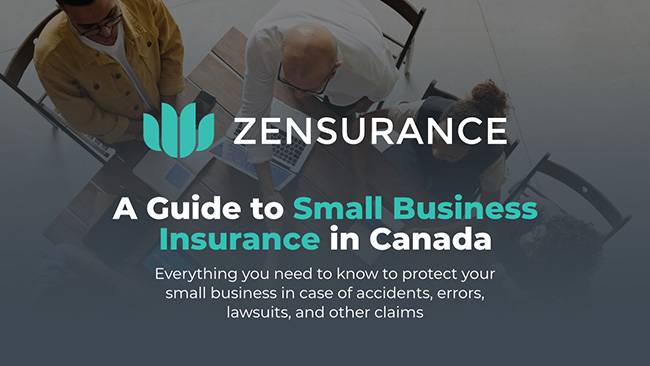The springtime is only 15 days away (hooray!). That means it’s vehicle maintenance time.
Here are nine tips for preparing your company vehicle for spring and avoiding accidents:
1. Change Your Tires and Check Wheel Alignment
It’s recommended to have winter tires installed on a vehicle from November to April. Once the temperature is consistently above 4C, it’s time to swap your tires and get all-season tires installed since the treads on winter tires wear down quicker in warmer temperatures. When your tires are being changed, that’s also a good time to have an auto technician check your vehicle’s wheel alignment. Additionally, check the tread depth on your all-season tires. Tires that are worn down won’t grip wet roads as effectively.

Download Our FREE Insurance Guide
Learn everything you need to protect your small business.
Whitepaper download
"*" indicates required fields
Your email address will be used by Zensurance to provide latest news, offers and tips.
You can unsubscribe at any time.

2. Check Your Lights
Headlights, taillights, signals and brake lights are all critical. Check all of them to ensure they don’t need new bulbs and are working correctly.
3. Have Your Brakes Inspected
Your vehicle’s braking system should be inspected by an auto technician every six months to ensure they’re in good condition and there’s adequate, clean braking fluid in the braking reservoir. Road salt and de-icing chemicals used on roads in the winter can damage your brakes.
4. Replace Your Windshield Wipers
It’s wise to replace your windshield wipers after every winter. Generally, wiper blades should be replaced twice annually to ensure optimal performance and good visibility. If your vehicle’s wiper blades show signs of cracks, make squeaking or scraping noises when in use, or leave streaks across the windshield, those are signs it’s time to replace them.
5. Inspect Hoses and Belts
Pop open the hood of your vehicle and carefully inspect all the hoses and belts for any cracking, leaks, or swelling in the hoses and ensure the drive belts are in good condition. Be sure to check the radiator for cracks and leaks and ensure the vehicle’s coolant and antifreeze levels are where they should be.
6. Get an Oil Change and Check Fluids
Regular oil and oil filter changes are necessary for all vehicle types. Check the owner’s manual for the manufacturer’s recommendations on how frequently you should do so. Getting your oil changed every 8,000 kilometres or every six months is common. But for business vehicles logging a lot of kilometres or hauling trailers and heavy loads, you might need to have the oil changed more frequently. Also, have an auto technician check all the fluids in your vehicle and ensure they’re topped up.
7. Test the Battery
Vehicle batteries are designed to last for up to five years. The extreme temperatures cars and trucks go through in Canada put a lot of strain on your vehicle’s battery and can affect the battery’s life. If your battery is nearing the end of the line, replace it before summer’s heat arrives.
8. Review Your Commercial Auto Insurance Coverage
A commercial auto policy needs to be renewed annually. It’s worthwhile to review your policy to ensure you have an adequate amount of coverage for your wheels. A Zensurance broker can help you do that.
9. Thoroughly Clean Your Vehicle
All the road salt, grit, and grime that builds up on your vehicle and along the undercarriage during the winter can lead to rusting. Thoroughly cleaning your vehicle helps preserve its longevity, and a sparkling, clean vehicle can help make a positive impression on your customers.
Driving Safety Tips for Spring
Springtime gets people moving. They want to be outdoors and enjoy the sunshine and mild temperatures. That means more pedestrians, cyclists, and motorcycles on the road. Contrary to popular belief, there tend to be more car accidents in the spring and summer than in winter.
Transport Canada (TC) reported there were 1,310 auto accidents involving a commercial vehicle in 2021, the highest number recorded since 2002. Moreover, TC noted the three most frequent contributing factors in fatal collisions in 2021 were “human factors” (76%), speeding (25%), and distracted driving (20%).
Consider the following driving safety tips before taking to the road this spring:
- Don’t be a distracted driver. Distracted driving is as great a threat to driving safely as is driving impaired. According to the Traffic Injury Research Foundation, 20% to 30% of fatal collisions in North America can be attributed to distracted driving, making it comparable to drinking and driving. Moreover, data from CAA says 47% of Canadians admit to using a mobile device to text or make calls while driving, and drivers who drive distracted are eight times more likely to be in a crash.
- Never drive if impaired or fatigued. We all know it’s reckless and dangerous to drive while impaired by alcohol or drugs, and yet impaired driving remains a significant threat in Canada. For example, the Ontario Provincial Police laid over 11,000 impaired driving charges in 2023, a 7% increase from 2022. Make it a rule never to get behind the wheel after consuming alcohol or drugs. Likewise, driving fatigued or while drowsy is the third-highest cause of collisions. The Canadian Council of Motor Transport Administrators says 21% of collisions are caused by driver fatigue. That amounts to around 400 deaths and 2,100 serious injuries every year. That’s enough reason to ensure you’re fully rested before driving.
- Prepare for daylight saving time. Speaking of fatigue, Sunday, March 10, is when daylight saving time begins this year (when clocks spring forward by one hour). Losing an hour of sleep can dramatically impact your alertness behind the wheel. The Canadian Centre for Occupational Health and Safety reports traffic accidents increase by 23% the following Monday. Be sure to go to bed an hour earlier the night before to allow your body to adapt so you’re rested and alert the next day.
- Watch out for children and pedestrians. With more children and pedestrians out and about as the warm weather arrives, the onus is on motorists to be mindful of them, especially when driving through school zones, residential areas, and near parks and playgrounds. Children, especially, may dart out into the street without warning. Always watch for kids on bikes, playing ball, or running around in the late afternoon.
- Share the road with cyclists. Even in the winter months, cyclists can be seen traversing city streets, but expect a lot more of them in the spring and summer. Be cautious when making right-hand turns by checking your mirrors to ensure there isn’t a cyclist coming up behind you or riding alongside your vehicle, and give them plenty of room when passing them.
- Keep an eye out for motorcyclists. Warmer weather means there’ll be more motorcyclists on highways and city streets. Check your blind spots, always know when a motorcycle is approaching you from behind, and always signal whenever you’re changing lanes or turning.
- Drive the speed limit. Speeding is one of the biggest contributors to collisions on our roads. Data in 2021 from Transport Canada shows 25% of fatal collisions involved a speeding motorist. Driving the posted speed limit can help reduce the risk of getting into a collision and prevent you from racking up traffic tickets and expensive fines (your driving record directly impacts the annual premium you’ll pay for auto insurance). Also, posted speed limits only apply to ideal driving conditions, so in poor weather, your driving speed should match the conditions.
- Beware of potholes in the road. Winter conditions damage roads and streets and create potholes that can damage your vehicle’s suspension and wheel alignment and puncture tires if you drive over one. Keep an eye out for these hazards, and if you can’t avoid a pothole, reduce your speed if it is safe to do so before driving over one. If your vehicle is damaged after hitting a pothole, and you have optional collision or all-perils coverage as part of our commercial auto policy, you can file a claim to pay for the repairs.
- Drive slowly through construction zones. Spring and summer usually mean road construction almost everywhere you drive. Drive slowly through construction zones to avoid injuring workers or other vehicles.
- Use your full headlighting system when driving in bad weather. Heavy rainfall, sudden downpours, and fog are common in the spring and can reduce visibility while driving. Switch on your vehicle’s entire headlighting system in inclement weather to improve visibility and ensure other motorists and pedestrians see you.
Why Does Your Business Vehicle Need Commercial Auto Insurance?
Whether you’re driving a company vehicle or your truck or car for work, you should have commercial auto insurance since most private-passenger car insurance policies are not designed to cover vehicles used for business purposes, or your coverage is likely insufficient if you get into an accident.
Fill out our online application for a free quote. Let Zensurance get the low-cost commercial auto insurance protection to cover any damages or losses to your company car, truck, van, or SUV.
Recent Posts
How to Prevent Phishing Attacks
Phishing attacks are among the most pervasive cyber-attacks against small businesses and independent professionals. Learn more about it and how to prevent your company from falling prey to it.
Zensurance Business Grant Winner 2024: Down East Dance Academy
Meet our $10,000 and $1,000 small business grant winners, their advice for other business owners and entrepreneurs, and why insurance is an essential part of their financial wellness.
5 Common Winter Business Insurance Claims
Accidents and mishaps leading to insurance claims can happen to any business owner at any time, but winter weather can raise the stakes considerably. Here are five wintertime claims our clients had to contend with and how their insurance coverage helped them recover.








